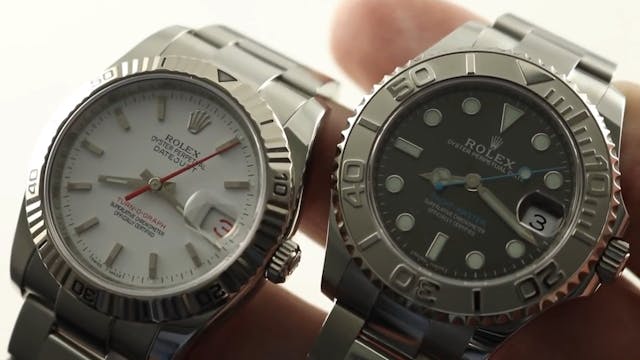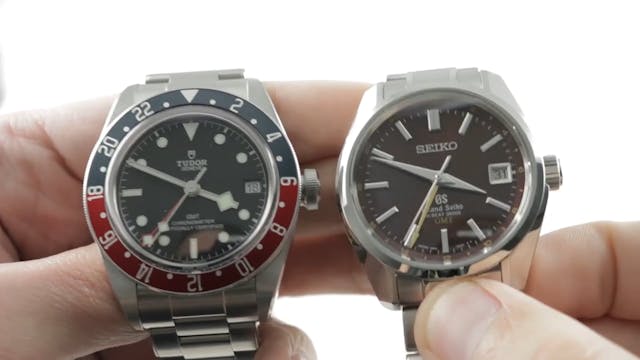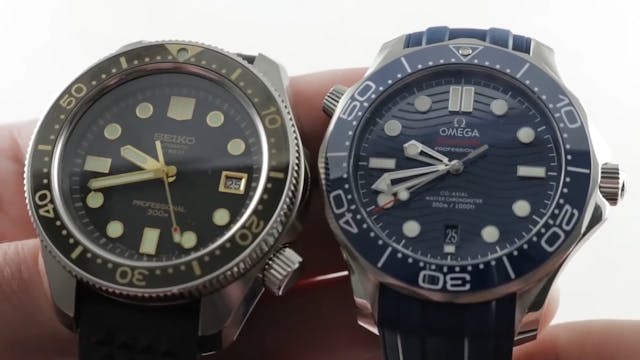Rolex Yacht-Master 37 116655 vs YachtMaster 40 268655
Versus
•
9m 0s
The Rolex Yacht-Master 37mm 268655 is encased in 37mm of Everose gold surrounding a black dial on a black Oysterflex bracelet. Functions include hours, minutes, seconds, and date. The watch also measures 10.7mm in thickness and 43.7mm from lug-to-lug.
The Rolex Yacht-Master 40mm 116655 is encased in 40mm of Everose gold surrounding a black dial on a black Oysterflex bracelet. Functions include hours, minutes, seconds, and date. The watch also measures 11.5mm in thickness and 48.2mm from lug-to-lug.
Shop Rolex: https://www.thewatchbox.com/watches/rolex/
For complete details, watch the full review!
Shop Rolex Yacht-Master: https://www.thewatchbox.com/watches/rolex/rolex-yacht-master/
Hi, this is Tim. Welcome to our channel and thanks for logging on. I don't know how it took over 3 years to make this happen, but today we're finally discussing the 40 millimeter Yacht-Master Sarah Chrome Oyster Flex, and the 37 millimeter Yacht-Master Sarah Chrome Oyster Flex, both Baudot SIHH 2015. They were the debut of ceramic vessel Yacht-Masters and the new Rolex Oyster Flex strap looking bracelet. And yes, it is a strap looking bracelet. We'll get into that in a moment. And you're probably more familiar with the 40 millimeter watch, the 116655, because it's more traditional. And I think more guys probably reached straight for this model. Guys, being the meat of the market, we tend to see more of them and not enough folks consider it as an alternative to the 37. So much as the only choice.
On my wrist. It's an imposing timepiece, 40 millimeters. It does look bigger because it's a big chunk of red, gold and Rolex ever rose red gold with a high copper percentage is intense. At 11.5 millimeters it's thinner than the sub and it's thinner than the Daytona, but it still looks like them and cuts the same stance on the wrist. 48.2 millimeters lug to lug, twenty millimeters is the lug spacing. But let's face it, if you get it with the Oyster Flex, you're going to wear it with the Oyster Flex. I can't see anyone accessorizing this with a rubber be. The strap has a wonderful flexibility about it. Lives up to its name, both Oyster and Flex, and you can pull it straight down around the tight curve of a smaller wrist. The material is molded to look a lot like a tapered Rolex bracelet. And on the underside, it really struts its stuff with a bellows system that both creates an air pocket to aerate the wrist and keeps it cinched down to the wrist. The watch does have a Oyster style clasp and it's nicely executed in red gold to match the timepiece. But you'll also note that in a break from most of the rotating bezel Rolex sports watches, this one has multiple anchoring points inside the class, but it doesn't actually have the easy link, quick adjust system. So you're going to want to choose the correct Oyster Flex strap that comes as close as possible to fitting your wrist. After that, you fine tune with the anchoring points and you're strapped to inside the clasp.
It's a very solid piece and it actually features a lock. So once you close it, you can't accidentally pull it open. I'm really wrenching it. It is a hook and beeks system that unlocks much like a trigger. So it actually has 2 closures and the clamshell is the second. The case is imposing, but more Datejust like or Daytona like than Sub like, it isn't shear, it isn't squared off. It doesn't feel blockish, unlike the Sub and the other aggressive sports watches such as the GMT, the Sea-Dweller, and the Explorer II. This feels more like a fusion of a Rolex aquatic sports watch and a dress watch. The bezel is bidirectional rotating and it features a handsome, relieved cerachrom so you have the raised portions which are of high polish. And then you have the matte base and it's quite handsome, nicely keyed to the Oyster Flex strap bracelet, as well as the dial.
About that. Why do I keep calling it a bracelet? Because it is. Oyster Flex is a titanium nickel alloy that runs all the way around. It's joined together at the center, at the clasp. So there's metal running from lug to lug around this watch. Don't be deceived into thinking that's rubber. It cannot tear straight through. The dial is all of matte black and nicely granular. It has a very light, pebbly quality. It has elements of rose gold, gilt style printing, oversize indices with Rolex Croma Light Loom, Cyclops eye magnifier, and of course that red shock at 6 o'clock. It's a colorful and handsome watch, on the inside 48 hour automatic 3135 bidirectional winding COSC chronometer tough with a full balance bridge and a free sprung architecture as well as a power chrom blue ferriss that is metal and an iron based over coil hair spring anti magnetic, not a magnetic, but with a bergé overcoiled to help it keep excellent time in multiple positions. It is a COSC certified swiss chronometer and it uses a Rolex twinlock or excuse me, Trip lock Crown. Despite being a 100 meter case, it's a Trip lock Crown as you'd find on a sub. I suspect 100 meters is a very conservative rating for this watch.
OK, now jumping over to the 268655. From a distance, you might not be able to tell the 2 watches apart as Rolex has succeeded in keeping them proportionally very close. The main distinction is going to be the width of the bezel, which is almost identical from watch to watch. And ultimately is your only overt visual cue. The aspect ratio of the bezel with respect to the case, this is a timepiece that still wears impressively on any wrist and it has real wrist presence. I would compare it favorably to a 1950s Rolex Submariner. Now, those were about this size and once you throw it on a 16 centimeter circumference wrist like mine, you could easily think that this is a 38 or 39. Traditionally sized, this is the pick for Rolex vintage enthusiasts who want a modern Rolex watch that they can wear in the water and wear without any concerns about scratching a crystal or magnetizing a hair spring. And that's important. First, let's talk about the thickness. It's a little bit thinner at 10.7 versus 11.5 for the standard watch. And across the wrist, it's considerably more compact at 43.7. 37 millimeters is the size. It wears bigger by far than a 36 millimeter Datejust even in terms of thickness and lug to lug, they're fairly close. There are no real changes about the clasp and the Oyster Flex. They're identical in every respect, right down to the internal sizing stations where you can re-anchor the bracelet.
The timepiece has an internal refinement that surpasses anything you'll find on the 40 millimeter watch. If you're into movements, this is the one you're going to want: 55 hour power reserve rather than 48 and a Rolex Siloxy hairspring in the caliber 2236. This is Rolex's first series application of a silicon hairspring, longer power reserve, silicone hairspring and a different cap atop the balance staff. It is in terms of architecture distinct from the 3135, right down to using distinct shock protection. So it does help to see the watches alongside each other. But remember, what really counts here is going to be individual taste and what's inside the case as the 37 millimeter watch is simply more interesting from a technological standpoint.
So let's talk about the advantages of each. 40 millimeter you're up first. Ok legibility day or night, a bigger dial, more loom, easier to see. Also, with everything more spread out, the dial is a bit better balanced. So it's both more legible and esthetically, a bit more appealing. The Cyclops eye on a 37, as well as somewhat more crowded indices, even though they are smaller proportionally, doesn't look quite as natural as the larger watch. Also important to recommend this watch is a more modern wrist stance. When you put a 40 millimeter watch on the wrist, it's going to appear more 2018 than a 37 millimeter, 100 meter water resistant sports watch. The 37 feels like a highly refined version of a 20th century Rolex, whereas this feels very much like a 21st century Rolex or timepiece of any brand.
Wrist presence. 40 beats 37. Especially when you compare the lug to lug dimensions. There's simply a lot more gold scrolling out across the wrist with this timepiece. And for those who want their watches to be seen, the wrist presence goes tandem with the notion that more Rolex is better. If you want visibility, prestige, stature, this timepiece does communicate that. And for a lot of folks buying a gold Rolex, that's a serious consideration. It's not my style, but you'll get more of it in the 40 just as you get more gold Rolex with the 40.
Now jumping over to the 37. Hands down, better fit. They're going to be more wrists that wear this watch, which should be regarded as a versatile uni size option rather than a ladies watch. It's not marketed as a ladies watch by Rolex, nor do I regard it as such. It has impressive presence in its own right and it gives you rare discretion in a full gold Rolex. These tend to be timepieces that you have to wear overtly with a great deal of confidence and an extroverted sensibility about you. Well, you don't need that when the watch is smaller. Colored gold, in my opinion, tends to work better in a small watch. It's also important to note that it fits like a 50s Sub or a 50s GMT. And for me, that's a wonderful throwback quality in a watch that has modern durability, reliability, scratch resistant sapphire, and water resistance.
Finally tech sophistication, more power reserve, Silicon Hairspring, the wave of the future at Rolex. If you want to be on the cutting edge, you're going to buy the 37, not the 40.
OK guys, now you've heard my decision. You've also gotten a rundown of the 2 watches. Let me know in the chat box which of these Yacht-Masters you would take home for your lonesome.
Nocturnal navigation with our dueling Yacht-Masters, I have to admit, after all is said, I'm a 37 millimeter Yar-Master guy. You guys let me know in the comments below which one you choose.
Up Next in Versus
-
Rolex Datejust Turn O Graph vs Yacht ...
Rolex vs Rolex comparisons are a watch buyer’s favorite pastime! This episode of Versus pits the discontinued Rolex Oyster Perpetual Datejust Turn-O-Graph 116264 against the Rolex Oyster Perpetual Yacht-Master midsize 268622. Both of these Rolex sports watches combine the company’s vaunted 904L s...
-
Tudor Black Bay GMT 79830RB versus Gr...
The Grand Seiko Hi-Beat 36000 GMT Limited Edition SBGJ021 features a 40mm stainless steel case surrounding a maroon dial on a stainless steel bracelet with folding buckle. Functions include hours, minutes, seconds, date and GMT. The watch also measures 14.5mm in thickness and 46.3mm from lug-to-l...
-
Omega Seamaster Diver 300M vs Seiko P...
The Omega Seamaster Diver 300m Co-Axial Master Chronometer (210.32.42.20.03.001) is encased in 42mm of stainless steel surrounding a blue wave dial on a blue rubber strap. This is the classic James Bond Omega Seamaster updated for its 25th anniversary. Functions include hours, minutes, seconds, h...



